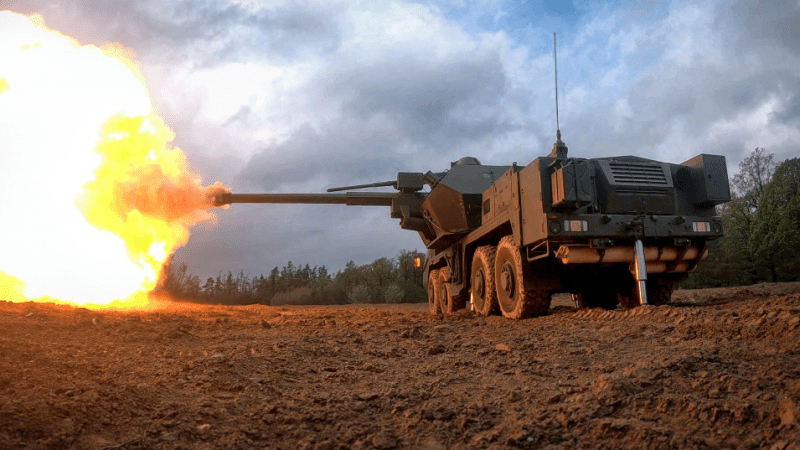- ANALIZA
- WIADOMOŚCI
Kryl Howitzer Cancelled. What About Dana in Poland? [Analysis]
The Kryl gun-howitzer procurement programme run by the Polish MoD has been, most probably, frozen. Numerous doubts and questions arise, regarding the future of the Dana howitzers, operated by the Polish Army.

Dana gun-howitzers have been operated by the Polish Army for a few decades now. Currently, they act as a fire support measure for the motorized units (a term used to refer to mecanized units using wheeled APCs) that, apart from being used on the Polish training ranges, was also deployed to Afghanistan. Some examples have been in service for 4 decades now. As the Kryl howitzer programme was frozen (or even canceled), and that howitzer was to replace the Polish Danas, one needs to consider options for future developments, regarding the Czechoslovak artillery assets in the Polish Armed Forces.
On 29th July 2019, an agreement was signed, assuming overhauls and modernization would be carried out with regard to the Dana systems so that they would become upgraded to the Dana-M standard. The contract value was defined as PLN 16.6 million, while the deadline for completion was set in the years 2019-2021. The schedule assumed that the work would involve one example per annum. WZU Grudziądz, and the EG Polska Sp. z o.o. company became the entities responsible for the aforesaid process. The latter business owns the license pertaining to the technologies applied. The goal of the upgrade was to diminish operational costs, increase mobility, and enhance the user experience. It was not, however, decided to replace the main gun with a NATO-compliant counterpart. Back then it was assumed that the upgrades would extend the service life of the Dana system in Poland by 2 decades. Ultimately, procurement of an entirely new artillery system within the framework of the Kryl programme was to be the final solution.
As the main gun of the Dana howitzer was not going to be replaced, the Polish Ministry of Defence started seeking options to procure new munitions for the wheeled howitzers. Currently, the standard HE munitions can be used at a range of 18-20 kilometres. Because 40 kilometres has become a golden standard in the West these days, the performance sheet as such may be considered to be insufficient. Despite numerous announcements made by the MoD, no specific actions were taken in that regard. We may also suspect that the Polish 152.4 mm munitions stockpile is limited, considering the military aid scheme launched, to support Ukraine.
See also

That also includes the plans aimed at increasing the number of motorized units, that would operate wheeled APC/IFV platforms. In the nearest future, the number of artillery systems supporting those elements may become insufficient. The Polish Ministry of Defence has been assuming that the units operating the Rosomak KTO (Polish acronym referring to a wheeled APC/IFV) would be operating wheeled artillery assets, such as Dana or Kryl. In the recent period that assumption was questioned, given the plan aimed at procurement of major quantities of tracked K9 family systems, including the Krab howitzers.
Let us go back to the efforts aimed at upgrading the Dana howitzers. The Armed Forces Support Inspectorate was planning to sign another, 3-year term contract on overhauls and upgrades of the Dana systems, to the Dana-M standard, back in 2022. The contract was to refer to another 7 examples of the Czechoslovak gun-howitzers. The project was finalized within the term between 2022 and 2024. The Support Inspectorate did confirm that so far, the Armed Forces received 3 DANA-M systems, meaning that no works have been finalized, apart from the effort covered by Agreement No. 5/W/2019, including:
- 2019: Overhaul with modification - 1 example;
- 2020: Overhaul with modification - 1 example;
- 2021: Overhaul with modification - 1 example;
Therefore, the Polish Army currently operates 111 (at least officially) examples of the wz. 77 artillery system in three variants: the baseline, original variant; DANA-T (upgraded with the Topaz fire control system), and DANA-M. A decision on a potential restart of the upgrades needs to be made by the Directorate of the Artillery and Rocket Component of the General Command of the Polish Armed Forces. Let us consider several scenarios that may emerge, given the current status quo.
Modernization - is it worth a shot?
The current problems faced by the Dana howitzer, also in the domain of its tactical performance sheet, could be resolved by an upgrade to the standard corresponding with DITA or Zuzana 2 systems. As the aforesaid howitzers feature longer barrels (L/45 and L/52, respectively), adopted to fire the NATO-compliant 155 mm round, we could expect a major range extension, and better performance in the realms of accuracy, or crew protection levels. Depending on the scope of work required to replace the barrel, in-depth modification of the autoloader system would also be required. Going even further, the resultant weight increase would require the integration of a new, more powerful engine (such as a turbocharged Tatra engine, replacing the normally aspirated engine used now), to maintain a reasonable level of vehicle mobility.
The scope of upgrades and overhaul for the DANA howitzer would need to be defined by the designers, contractors, and by the Armed Forces. This is because of the long service of those systems - which must have had a major impact on the durability and lifetime of many components. One of the most interesting solutions would envisage the revival of the idea of placing a new 155 mm/L45 howitzer in the turret, in combination with the changes implemented in the case of the DANA-M variant. That hybrid solution would be based on the proposal made by the Czech Excalibur Army company for DANA-M2 (a base for the Polish Dana upgrade), and the DITA demonstrator.
However, one should ask a question regarding the cost - whether the cost outweighs the procurement of an entirely new artillery piece, with an even better performance sheet, and bigger developmental headroom. The DANA DITA upgrade seems to be a bit over the top, given the number of changes that need to be made to the platform, required to integrate a new turret with a modified autoloader.
The Return of the Kryl
If the Polish Armed Forces come to the conclusion that they need wheeled self-propelled artillery assets for integration with motorized units, and also assume that an upgrade of the Dana system is not a cost-effective solution, it would be required to unfreeze the Kryl programme. Apart from the obvious change in the requirements that had been defined over a decade ago, it would also be required to analyze the Polish industry's capacity to manufacture such artillery systems.
Given the number of orders, and the limited manufacturing capacity in the foreseeable future, when it comes to the Polish artillery giant, HSW S.A., there is a possibility that the Kryl system would need to be procured abroad, or developed through joint, international cooperation. Numerous solutions used now, in this area, remain very flexible when it comes to integration with several different base platforms, such as the Israeli ATMOS 2000 used in the Kryl project, or the French CAESAR system. Anyway, one of the Jelcz trucks would probably be used as a base platform here. Another option would be to use a different base, such as the Tatra 815 truck, that has been operated by the Polish Armed Forces for decades (as a base for the DANA, or for the RM-70 systems).
Is the dispute justified?
Ever since the beginning of the Russian aggression in Ukraine, Poland has been heavily involved in the delivery of various armaments for the defenders. It all started with the Piorun MANPADS, and the effort escalated, as Poland finally transferred the state-of-the-art heavy platforms offered by the Polish industry, such as the Krab howitzers. It may also be assumed that some of the Dana howitzers from the Polish inventory also were transferred to Ukraine, as the OSINT content seems to suggest. Officially the Czech Republic was the donor, with an impressive stockpile of spares for the said howitzer. However, some rumors suggest that a certain number of DANA howitzers were also provided by Poland. It is possible that the above development, as well as the acquisition of the Korean K9 systems, have both become the reason why no agreement was signed aimed at further upgrades of the owned howitzers, to the DANA-M standard. As the Kryl programme has been suspended due to the redefinition of requirements, we may expect the Dana system to be decommissioned, without any imminent prospect of procurement of a worthy successor. This would end an anomaly of a Warsaw Pact nation choosing the Dana system, instead of the tracked 2S1 Akatsya.

















